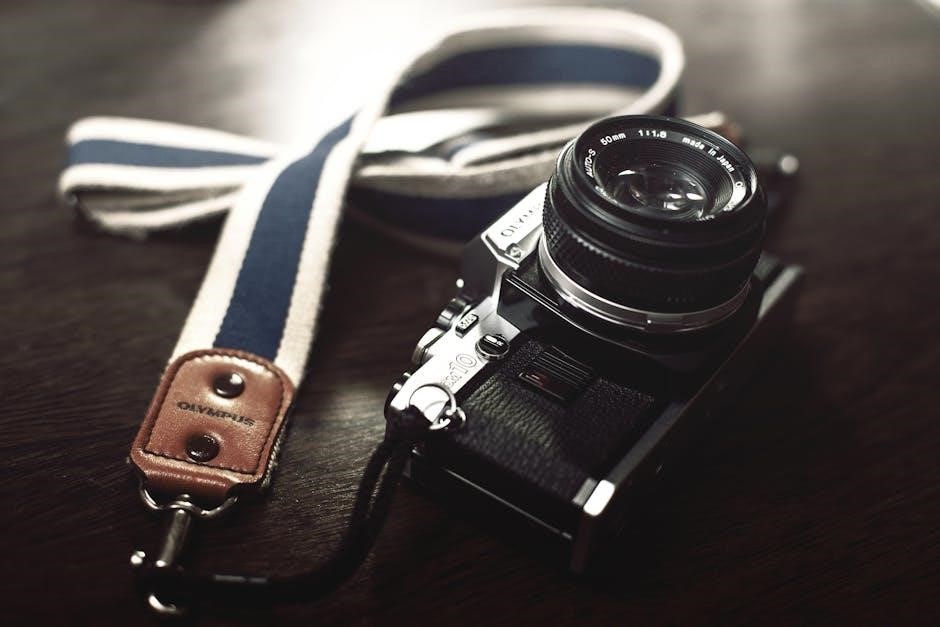Olympus OM-1: A Comprehensive Guide
The Olympus OM-1, a celebrated 35mm SLR, is known for its compact design and fully manual operation. This guide provides a comprehensive overview, drawing from user manuals and online resources, to help you master this classic camera.
The Olympus OM-1, introduced in 1972, marked a significant shift in SLR design, prioritizing compact size and lightweight construction without compromising image quality or functionality. This manual-focus, 35mm single-lens reflex (SLR) camera quickly gained popularity among photographers seeking a more portable and ergonomic alternative to larger, heavier cameras of the era. Its fully mechanical operation, coupled with a bright viewfinder and a wide range of high-quality OM System Zuiko lenses, made it a favorite for both amateur and professional photographers. The OM-1’s design philosophy emphasized simplicity and reliability, offering a direct and tactile shooting experience that many photographers still appreciate today. While fully manual, the camera’s intuitive controls and excellent metering system allow for precise exposure control. Understanding the nuances of the OM-1’s operation, from its unique shutter speed dial to its compatibility with various accessories, is key to unlocking its full potential. This guide will delve into the camera’s features, handling, and maintenance, providing you with the knowledge to confidently use and care for your Olympus OM-1. Whether you’re a seasoned film photographer or new to the world of classic cameras, this comprehensive guide will serve as a valuable resource for mastering the Olympus OM-1.

Overview of the Olympus OM-1
The Olympus OM-1 is a classic 35mm SLR renowned for its compact size and manual operation. This section will explore its key features and specifications, providing a solid foundation for understanding this iconic camera.
Key Features and Specifications
The Olympus OM-1, introduced in 1972, is a fully manual 35mm single-lens reflex (SLR) camera celebrated for its compact size and innovative design. Key features include its all-mechanical operation, requiring no battery for basic functions (metering excluded), a bright viewfinder, and a unique shutter speed dial located around the lens mount. The camera accepts Olympus OM-mount lenses, known for their quality and compact design. Its specifications include a horizontal cloth focal-plane shutter with speeds ranging from 1 second to 1/1000th of a second, plus Bulb mode for long exposures. The OM-1 uses a center-weighted metering system, providing accurate exposure readings. While the original OM-1 used a mercury battery for its light meter, many have been modified to accept readily available 1.5V SR44 batteries or zinc-air hearing aid batteries. The camera’s viewfinder offers a clear and bright view, aiding in precise focusing and composition. The OM-1’s robust construction and fully mechanical operation make it a reliable choice for photographers seeking a classic film experience. Additionally, the availability of various accessories, such as hot shoes for flash units, expands the camera’s versatility. The OM system lenses, often featuring built-in lens hoods, are highly regarded for their sharpness and smooth focusing. The OM-1’s enduring popularity stems from its blend of compact size, robust build quality, and exceptional image quality when paired with Zuiko lenses.

Handling and Operation
The Olympus OM-1 offers a unique handling experience due to its distinctive control layout. Understanding the shutter speed dial and viewfinder is crucial for effective operation. This section will guide you through these key aspects.
Shutter Speed Dial and Controls
The Olympus OM-1 features a distinctive shutter speed dial, a departure from the conventional top-mounted design found on many other cameras. Instead, the shutter speed dial is located as a ring around the lens mount. This placement might seem unusual at first, but many users find it ergonomically efficient once they become accustomed to it. The dial is designed to be buttery smooth, allowing for precise adjustments with minimal effort. This tactile feedback enhances the overall shooting experience, making it a joy to use. Some users even prefer this design over the traditional top-mounted dials, citing its ease of access and intuitive feel. The dial’s responsiveness and smooth operation contribute to the camera’s overall sense of quality and precision. However, new users should be aware of its location and take some time to familiarize themselves with its operation. With practice, adjusting shutter speed becomes second nature. It’s a feature that many OM-1 enthusiasts appreciate for its unique approach to camera control. Be mindful not to overtighten any accessories, especially the hot shoe, as plastic components can become brittle with age.
Viewfinder and Focusing
The Olympus OM-1 boasts a viewfinder that is often praised for its brightness and size, contributing significantly to a pleasant shooting experience. A clear and bright viewfinder is crucial for accurate composition and focusing, especially in manual mode. The OM-1’s viewfinder allows photographers to critically assess the scene before capturing the image, ensuring that the final result aligns with their artistic vision. The generous size of the viewfinder image makes it easier to spot fine details and confirm focus, which is particularly important when using fast lenses or shooting in challenging lighting conditions. Accurate focusing is essential for achieving sharp and detailed photographs, and the OM-1’s viewfinder plays a vital role in this process. The design and quality of the viewfinder are among the key factors that contribute to the camera’s popularity among film photography enthusiasts. The large and bright viewfinder makes manual focusing easier and more accurate. The OM-1 also offers features like diopter adjustment. This is beneficial for photographers who wear glasses. It allows them to adjust the viewfinder to their vision, ensuring a clear and comfortable view without needing to wear their glasses while shooting.

Batteries and Accessories
Powering your Olympus OM-1 and expanding its capabilities involve understanding battery options and compatible accessories. This section explores suitable batteries, considerations for their use, and flash compatibility for optimal performance.
Battery Options and Considerations
The original Olympus OM-1 was designed to use 1.35v mercury batteries, which are no longer readily available due to environmental concerns. This presents a challenge for users seeking to power the camera’s light meter. Several alternatives exist, each with its own set of considerations.
Zinc-Air Batteries: Hearing aid batteries are a popular substitute. These 1.4v zinc-air batteries provide a voltage close to the original mercury cells. However, their lifespan is shorter, as they are activated upon exposure to air. It is advisable to keep them sealed until use. Also, they may require an adapter ring to fit snugly in the battery compartment.
SR44/LR44 Batteries with Diode Modification: Some OM-1 cameras have been modified with a Schottky diode to compensate for the higher voltage of 1.5v silver oxide (SR44) or alkaline (LR44) batteries. If your camera has this modification, using these batteries is a straightforward solution. Consult the seller or a camera technician to determine if your OM-1 has been modified.
External Light Meter: An alternative to using batteries within the camera is to rely on an external light meter. This method bypasses the need for a working internal meter altogether, providing accurate exposure readings independently.
Voltage Adapters: Adapters that regulate the voltage of modern batteries to the required 1.35v are also available. These adapters offer a more consistent and accurate voltage supply, ensuring proper light meter function.
When selecting a battery option, consider the accuracy of the light meter readings, battery life, and the potential need for camera modifications or adapters. Regular monitoring of exposure is recommended, especially when using substitute batteries.
Hot Shoe and Flash Compatibility
The Olympus OM-1 features a unique flash compatibility system. Unlike many cameras with a built-in hot shoe, the OM-1 utilizes a detachable hot shoe, which slides onto the camera’s pentaprism. This design allowed Olympus to offer different hot shoe options, catering to various flash functionalities.
Detachable Hot Shoe: The most common hot shoe for the OM-1 is the standard shoe, providing basic flash sync; It connects to the camera via the PC sync terminal, located on the front of the camera body. When attaching the hot shoe, ensure it is securely fastened to prevent accidental disconnections.
Flash Synchronization: The OM-1 synchronizes with electronic flashes at a shutter speed of 1/60th of a second. Using faster shutter speeds may result in only a portion of the frame being illuminated by the flash. For optimal flash performance, set the shutter speed to 1/60th or slower.
Dedicated Olympus Flashes: Olympus offered a range of dedicated flashes designed to work seamlessly with the OM system. These flashes often provided features such as automatic flash exposure and viewfinder-ready indicators.
Third-Party Flashes: While dedicated Olympus flashes are ideal, the OM-1 is also compatible with many third-party flashes. However, ensure that the flash unit is compatible with manual flash control, as TTL (Through-The-Lens) flash metering is not supported without specific adapters or dedicated flash units designed for the OM system.
Hot Shoe Caution: The detachable hot shoe is made of plastic and can become brittle with age. Avoid overtightening the screw that secures it to the camera, as this can lead to cracking or breakage.
When using flash with the OM-1, it’s essential to understand the synchronization limitations and ensure proper compatibility between the camera and the flash unit. Experiment with different flash settings to achieve the desired lighting effect.
Maintenance and Care
Proper maintenance is crucial for preserving your Olympus OM-1. Regular cleaning and careful storage will ensure its longevity and optimal performance. This section provides essential tips for keeping your camera in top condition.
Cleaning and Storage Tips
To ensure your Olympus OM-1 remains in optimal condition, regular cleaning and proper storage are essential. Dust and debris can affect image quality and the camera’s mechanical functions. Use a soft, dry cloth to gently wipe the camera body, paying particular attention to the lens mount and film compartment. For the lens, use a lens brush to remove loose particles, followed by a lens cleaning cloth and a small amount of lens cleaning solution. Avoid applying excessive pressure, which could scratch the lens coating. Inspect the viewfinder regularly and clean it with a soft brush or air blower to remove any dust or fingerprints. When not in use, store your OM-1 in a cool, dry place, away from direct sunlight and extreme temperatures. A camera bag or case provides added protection against dust, moisture, and physical damage. If storing the camera for an extended period, remove the battery to prevent corrosion. Regularly check the light seals around the film door and replace them if they become brittle or deteriorated, as this can lead to light leaks and affect your photographs. By following these simple cleaning and storage tips, you can prolong the life of your Olympus OM-1 and maintain its performance for years to come.

Troubleshooting
Addressing common issues with your Olympus OM-1 can often be resolved with simple checks. This section provides guidance on diagnosing and fixing problems, ensuring your camera continues to perform reliably. Refer to the manual for detailed solutions.
Common Issues and Solutions
Many Olympus OM-1 users encounter similar challenges, and understanding these common issues can save time and frustration. One frequent problem is a non-functional light meter. This could stem from dead batteries, corrosion in the battery compartment, or a faulty meter cell. Try replacing the batteries first, ensuring they are correctly installed. If the meter still doesn’t work, carefully clean the battery contacts with a cotton swab and isopropyl alcohol. If these steps don’t resolve the issue, the meter cell may need professional repair. Another common concern is a sticky or unresponsive shutter. This is often due to old lubricants that have hardened over time. Exercising the shutter at various speeds may help loosen it up. If the problem persists, a CLA (Clean, Lube, and Adjust) service by a qualified technician is recommended. Additionally, users sometimes experience issues with the film advance mechanism. This could be caused by a broken or misaligned gear. Avoid forcing the film advance lever, as this can exacerbate the problem. Inspect the mechanism for any visible obstructions. If you’re comfortable, you can try lubricating the moving parts with a small amount of precision oil. However, if the issue is complex, seek professional assistance. Finally, be aware of potential issues with the hot shoe, particularly on models where it’s a screw-on accessory. Overtightening can damage the plastic, making it brittle. Handle the hot shoe with care and avoid excessive force when attaching it. If it breaks, replacements are available, but gentle handling is always best. These are just a few of the common issues that OM-1 users may face, and addressing them promptly can help ensure the longevity of your beloved camera.
